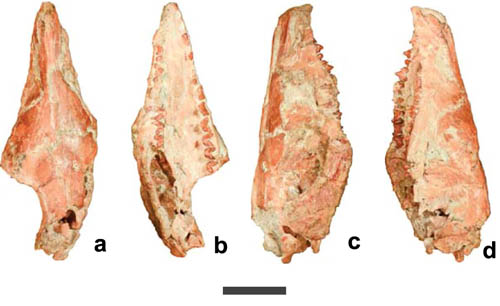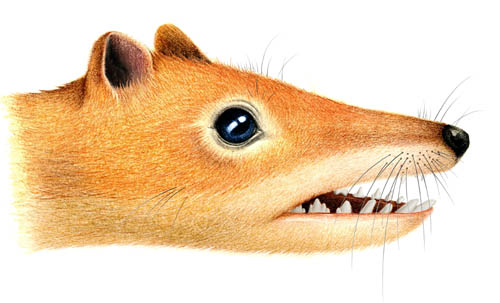New Symmetrodont Mammal Found from the Early Cretaceous of China
Mesozoic mammals with molariform teeth bearing a simple, triangular arrangement of principal cusps were traditionally assigned to the Order Symmetrodonta. Phylogenetic analyses imply that this grouping is artificial, with the symmetrodont molar pattern representing a structural grade that evolved multiple times.
In fact, weakly-triangulated molariforms, as represented by tinodontids, are present near the base of Mammalia in recent analyses, suggesting that this pattern was shared by the ancestors of dentally specialised but structurally disparate groups such as eutriconodontans, multituberculates, dryolestoids, and therians. Therefore, discoveries of well-preserved symmetrodont specimens have the potential to illuminate the morphological transitions that gave rise to therians.
Symmetrodonts with acutely-triangulated molar cusps (or “acute-angled symmetrodonts”) form a monophyletic group in recent analyses, positioned at the base of the Trechnotheria, a clade which also contains dryolestoids and therians. These symmetrodonts are known principally from the Early Cretaceous and became extinct prior to the Campanian. They segregate into two lineages: the Spalacotheriidae, a diverse group which contain some dentally specialised taxa bearing a high number of mesiodistally compressed molars, and the Zhangheotheriidae, a group restricted to Asia and bearing a more primitive dentition.
In a study published online May 24 in the journal Scientific Reports, Dr. BI Shundong of the Institute of Vertebrate Paleontology and Paleoanthropology (IVPP) of the Chinese Academy of Sciencesreport, and his collaborators reported the discovery of Anebodon luoi, a new genus and species of zhangheotheriid symmetrodont mammal from the Lujiatun site of the Lower Cretaceous Yixian Formation in Liaoning Province of China. This finding provides new information for discussion of trechnotherian character evolution, and ultimately sheds additional light on the evolution of therians.
The new specimen is an associated partial skull and dentaries with a nearly complete dentition, and it is referred to the Zhangheotheriidae based primarily on features of the dentition. It lacks the high molar count typical of derived symmetrodonts, and differs from the well-represented zhangheotheriids Zhangheotherium and Maotherium in having a postcanine dental formula that resembles more primitive tinodontid symmetrodonts on the one hand, and sister taxa to therians such as Peramus on the other.
Upper and lower distal premolars of Anebodon luoi are strongly molariform. Researchers captured undergoing tooth replacement, clarifying positional homology among related taxa.
“We interpret our specimen to have an upper postcanine formula of P5/M3, which is generally thought to be the primitive count for therians. Additionally, the penultimate upper premolar (P4) in Anebodon is the tallest tooth in the postcanine series, a feature also characteristic of therians. Some degree of molarization of the posterior premolars also occurs in various spalacotheriids, but evidence of replacement of strongly molariform teeth is currently lacking in this derived group. Retention of molariform premolars in the adult dentition is also a characteristic of the endemic South American meridiolestidan dryolestoids; the distribution of this feature suggests that it is basal to the Trechnotheria and possibly represents the primitive condition for the therian line,” said BI Shundong.
“We also describe the rostrum and, for the first time in a symmetrodont, much of the orbital mosaic. Importantly, our new taxon occupies a basal position within the Zhangheotheriidae and permits discussion of trechnotherian character evolution, ultimately shedding additional light on the evolution of therians,” said study co-author Brian Davis, a professor from the Department of Anatomical Sciences and Neurobiology at the University of Louisville.
The study was supported by the National Basic Research Program of China (973 program,), the National Science Foundation of China, and the Hundred Talents Programs of the Chinese Academy of Sciences.

Fig.1 Skull of the zhangheotheriid Anebodon luoi in dorsal (a), ventral (b), right lateral (c) and left lateral (d) views, scale bar 1 cm (Image by BI Shundong)

Fig.2 Reconstruction of zhangheotheriid Anebodon luoi (Image by SHI Aijuan)
Download attachments: